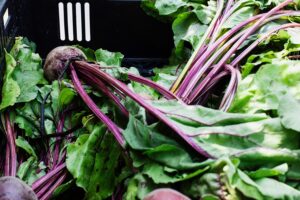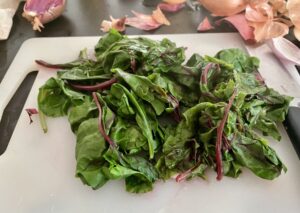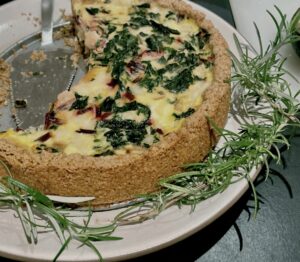Sometime during the early spring of 2020, a friend told me about an enterprising young couple who were, for a reasonable fee, building victory gardens in and around Wellfleet for cowering New Yorkers.
I was among those city people here during the first months of the pandemic, trying to transplant myself and my work as a filmmaker and spending endless evenings staring across the dining room table at my son, who glowered back at me and my boyfriend in the disappointed realization that we were not his freshman roommates stepping out to a party. In retrospect, I’m not sure the term victory garden was exactly accurate, though at the time it certainly felt like we were in a war.
Anyway, one afternoon, Blake Olsen and Jessica Taylor, who now run Sea and Soil Design, came over and walked around the outside of my house with me. After some discussion about the direction of the sun and where it crossed the sky at various times of year, they built me a garden. It consisted of two raised beds, and for a couple of springs and summers and falls I had mild aspirations of becoming a vegetable gardener. In other words, I tried to be a person I am not.

I confess to being shocked that first summer that these teeny things called seeds, which apparently you are supposed to put in the ground under a whole bunch of dirt, eventually pushed up through the soil and became plants. The fact that these plants were then edible was hard to get through my urban brain. It was super cool, though, from a miracle perspective, and I was glad to finally catch up to what everyone else has known for millennia.
Before long, though, reality set in. There were the swarms of mosquitoes I had to walk through to pick my dinner, and I had trouble keeping up with the lettuce — eating enough of it, I mean — and the rabbits liked the tomatoes more than I did. Once, a couple of delicata squash crept over the edge of the vegetable box and lay happily growing in the wood chips on top of my septic system. It gave me pleasure to see them there, defiant about living in boxes, but mostly my relationship to the garden was desultory. It filled me with anxiety.
At some point, I started going to the farmers markets. I felt guilty about the vegetable beds at home, like I was cheating on them. But I loved being able to simply say, “I’ll take three of those, please,” and voilà — no mosquitoes, no rabbits, no dirt under my nails. More to the point, the quality of the produce was enviable and undeniable. The revelation of the farmers markets for me was that, as with most things, the growing of vegetables (and fruit and chickens and granola, for that matter) is best left to the professionals.
I’ve decided that my role is to support them by buying my dinner — and lunch and breakfast, too — from them. I know how to cook. I know how to eat. I don’t need to know how to grow.

This summer, I have decreed that Stop & Shop is for toilet paper and dishwashing liquid. The farmers can decide what I’m cooking, or, really, the produce will point the way. That’s the main thing: you can’t go to the farmers market with a list. Some improvisation is required when you’re letting go of recipe-driven dinners.
Early in the season, I bought some beets, which came with their greens attached, augmenting the giant armfuls of other greens I was already lugging home. Then I invited a friend for dinner with a breezy, “Don’t worry, I’ll just cook what I have on hand.” I was thinking about some kind of salad with roasted beets, but what I needed to move were their greens.

Obviously, some kind of beet-green-and-cheese pie was in order. Feta would be nice, but I had halloumi, a harder version of feta that is often served grilled — it’s delicious, and it would do. I had an array of flours that needed using up and thought maybe the nuttiness of a mostly oat flour crust would complement the beet greens. Hoping the ghost of Julia Child would look away quietly and with love, I tossed it in the Cuisinart with some butter, and I was on my way to a crust that was too crumbly to be rolled but worked fine pressed into a springform pan. The greens would get a basic quiche treatment, and 45 minutes later: dinner, no mosquitoes.
USE-YOUR-GREENS PIE
Makes one 9- or 10-inch pie
For the crust
4 oz. butter, cold
¾ cup oat flour
½ cup gluten-free flour
2 Tbsp. Olive Oil
2 Tbsp. whole milk yogurt
A pinch of salt (omit if using salted butter)
Ice water
For the filling
A big bunch of greens: beet greens, kale, chard, spinach, in any combination
2 Tbsp. olive oil or butter
1 onion, finely chopped
5 eggs
¾ cup cream or half-and-half
8 oz. halloumi cheese (or feta), cut into smallish squares
Salt and pepper to taste
- Make the crust: Pulse the butter, flours, and olive oil in a food processor until the mixture resembles a coarse meal and the fats are integrated into the flours. (Stop before it becomes pasty.) Add the yogurt and pulse a couple of times. Pinch some of the dough together; if it holds, you’re set. If it doesn’t, add a little bit of ice water, a tablespoon at a time, until it does. If you’re using oat flour, the mixture will be crumbly and need to be pressed into a pie tin or springform pan.
- Prep the greens: They may have a lot of grit, so rinsing them in a big bowl with several changes of cold water is the way to go. Blanch them in boiling salted water for about three minutes and drain well; then, when they are cool enough to handle, squeeze out as much of the excess water as you can. Chop them well.
- Sauté the chopped onion in the olive oil or butter over medium high heat, and when it is translucent, add the greens. Sauté for about 10 minutes, stirring occasionally and adding salt and pepper to taste. Go light on the salt here because the halloumi is salty, but a heavy hand with the pepper is nice. Turn off the heat and let the greens cool slightly while you beat the eggs together with the cream in a large bowl. Add the cheese, then the greens, and mix well. Pour the filling into the pie crust and bake at 375° F for approximately 45 minutes, until it is lightly golden on top. Serve warm or at room temperature.
